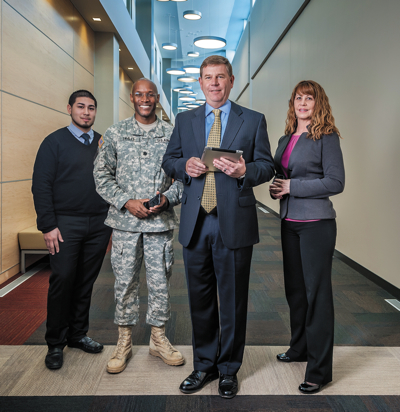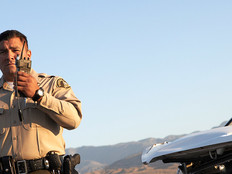For Defense Department Agencies, Mobile Technology Can Save Lives, Property and Time
Whether users are conducting procurement activities stateside or fighting wars overseas, John Hickey, program manager for mobility at the Defense Information Systems Agency (DISA), says when it comes to mobility and collaboration, his team aims to deliver the technology that makes the Defense Department more effective.
“We have a lot of federal and military personnel who travel around the national capital region daily as part of their primary duties,” Hickey explains. “It really helps for them to have a mobile capability, such as a smartphone or tablet, so they can collaborate with team members on the go. It gives them more flexibility to ensure we’re keeping warfighters’ needs at the forefront of every task and decision, whether in the office or on the move.”
Along the same lines, by using a mobile capability to the Global Combat Support System–Joint, soldiers can give their commanders the status of equipment in the field and use devices such as smartphones and tablets to track the supply chain. Hickey says DISA also plans to deliver a mobile capability to the Global Command and Control System–Joint, so the command and control team can track aircraft movement on classified mobile devices.
Hickey says DISA plans to use commercial unified communications technology to help Defense Department staffers collaborate. For starters, they plan to run smartphones over a VoIP network, a move that will save the government a considerable amount on cellphone charges. Hickey also envisions DOD team members using video chat on smartphones and running softphones on tablet devices.
“My goal is to deliver the mobile technologies that will enable the collaboration,” Hickey says.
Sharing Anywhere
The Defense Department and other agencies started by providing mobile devices to field workers but are now implementing such technology with rank and file workers as well, a trend that echoes practices in the private sector, says Chris Silva, an industry analyst who focuses on mobility for the Altimeter Group.
“In business, we see companies focusing on sales and field service people, while in government, that may equate to specific agencies that interface with the public or even soldiers in the field,” Silva says. “On the technology side, organizations tend to start with information-sharing tools, mobile workflows and giving a mobile capability to their internal systems such as order, inventory and production systems and then follow this with video capabilities for enhanced communication across the organization.”
John Hale, DISA’s chief of enterprise applications, who works closely with Hickey’s group, says DISA’s enterprise services enable users to share documents, imagery, maps and PowerPoint slides regardless of a mission partner’s location, service or agency. Hale says senior leaders for command and control are among the users of these enterprise services.
“They’re able to make comments on the documents, have discussions in real time and share the same information with multiple people,” Hale says. “Our goal is to make the decision-makers as well informed as possible.”
Hale says his group is also focused on supporting telework and expanding mobility to as many Defense Department employees as possible.
“As we shift to a more mobile workforce, just about everyone will be mobile, regardless of rank, role or mission,” Hale says. “Our mobility platforms will make that happen.”
Mobility Makes Sense
For the Defense Department, mobile technologies help users collaborate more effectively because so much of what they do is in the field. The same holds true for many other federal agencies, including the Agriculture Department and Bureau of Alcohol, Tobacco, Firearms and Explosives (ATF).
Jerome Davin, director of mobile computing and AgLearn Enterprise Applications Services (a departmentwide system for managing training records and activity at USDA), says out of the agency’s 100,000 employees, roughly one-third have a mobile capability via a notebook computer, smartphone or tablet. He says the agency supports most platforms and devices, including iOS and Android smartphones and tablets.
Davin says USDA employees collaborate with one another using a variety of mobile technologies. He says firefighters for the Forest Service use smartphones and tablets with both cellular and Wi-Fi capabilities to share real-time fire positions with the agency’s command-and-control center.

Photo: Brad Howell
DISA’s DOD mobility team, which includes (from left) Danny Valladares, Lt. Col. Douglas Smalls, John J. Hickey and Kelly J. Chott, wants to make collaboration tools available to both warfighters amd DOD support personnel.
“The firefighters can bring up satellite imagery on their tablets and send back information on where the fire is moving,” Davin says. “By seeing more clearly what’s going on, we can save lives and property.”
Other mobile applications used by USDA employees are replacing fieldwork that used to be done on paper, Davin says. Statisticians collect crop production data in the field and share the data with the National Agricultural Statistics Service and USDA executives in real time. Meat inspectors also use tablets to conduct plant inspections and share information about them. And USDA service center workers meet with farmers in the field and use mapping applications to determine how best to use land or undertake conservation programs.
USDA has also delivered a mobile version of USDA Connect, its web-based portal that lets the staff create communities to collaborate on projects. The tool lets staff members share documents, exchange instant messages and check email and calendars. Davin says plans are in the works to leverage Microsoft Lync to conduct video chats and other unified communications technologies on smartphones and tablets.
“Our overall goal is to streamline business processes, increase productivity, improve service quality and reduce costs,” Davin says. “And we believe that providing the workforce with mobility tools will help us achieve those goals.”
Mobile by Nature
Walter Bigelow, chief of the IT Systems Management Division at ATF, says using mobile tools to collaborate is central to the agency’s strategy.
“We support 7,000 people, and 3,500 of those are mobile workers,” he says, adding that the technology group supports 280 physical locations. “Delivering mobility is critical to our mission, which is why we’re trying to stay at the forefront of enabling our mobile workforce to get the features of the new technology to any device at any location.”
Bigelow says ATF has used tools such as Adobe Connect for the past year to run web conferences of training sessions to agents and industry investigators in the field. People can view the training session on an iPhone or iPad device, or they can set up a Wi-Fi hotspot using a smartphone to view the session on a notebook computer.
Moving forward, Bigelow and his team are working to make it possible for agents to view and monitor surveillance videos in the field via iPhone and iPad. The IT staff aims to combine the ability to view the surveillance video with access to Microsoft Office 365 applications and the ATF’s case management system, a capability that will let agents in the field file situation reports to headquarters from any device, whether it is based on iOS, Android or Windows Phone 8.
“We have a creative group of users, and I’m confident that they’ll take these tools and find ways to collaborate more effectively,” Bigelow says, adding that plans are also in the works to use video chat and other unified communications capabilities via Microsoft Lync and the Avaya Flare Experience.









